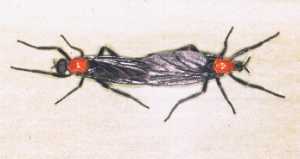Love Bugs Re-visited
On September 17th, 2007, I wrote about “unlovely love bugs.” Yesterday I was warned that “they’re back!”
Our friends, Wayne and Linda Conklin, who are already in Florida said we should be prepared. They’ve really invaded the south.
Again, for clarification, what are love bugs? I found this technical explanation:
The female is the larger one on the right.
 The love bug (also known as lovebug, march fly, honeymoon fly, telephone bug and double-headed bug) (scientific name Plecia nearctica) is a small flying insect common to the southern United States, especially along the Gulf Coast. It was first described in 1940 in Galveston, Texas, and was said to be invading Texas and Louisiana. By the end of the 20th century, however, it had spread heavily to all areas bordering the Gulf of Mexico, as well as Georgia, South Carolina, Florida, and other parts of Central America.
The love bug (also known as lovebug, march fly, honeymoon fly, telephone bug and double-headed bug) (scientific name Plecia nearctica) is a small flying insect common to the southern United States, especially along the Gulf Coast. It was first described in 1940 in Galveston, Texas, and was said to be invading Texas and Louisiana. By the end of the 20th century, however, it had spread heavily to all areas bordering the Gulf of Mexico, as well as Georgia, South Carolina, Florida, and other parts of Central America.
Just before we get into Florida, we generally see our first love bugs. They don’t bite, sting, stink, or buzz. But they are annoying because there are so many of them. And they are really hard on car finishes. Someone made a comment in something I read that lovebugs truly help the economy because so many people have to have their cars washed after driving through them. If you leave them on your car, they’ll permanently pit the finish. But even if an insecticide could be found to eliminate them, there’d be a lobby defending them, since so many folks earn money off them.